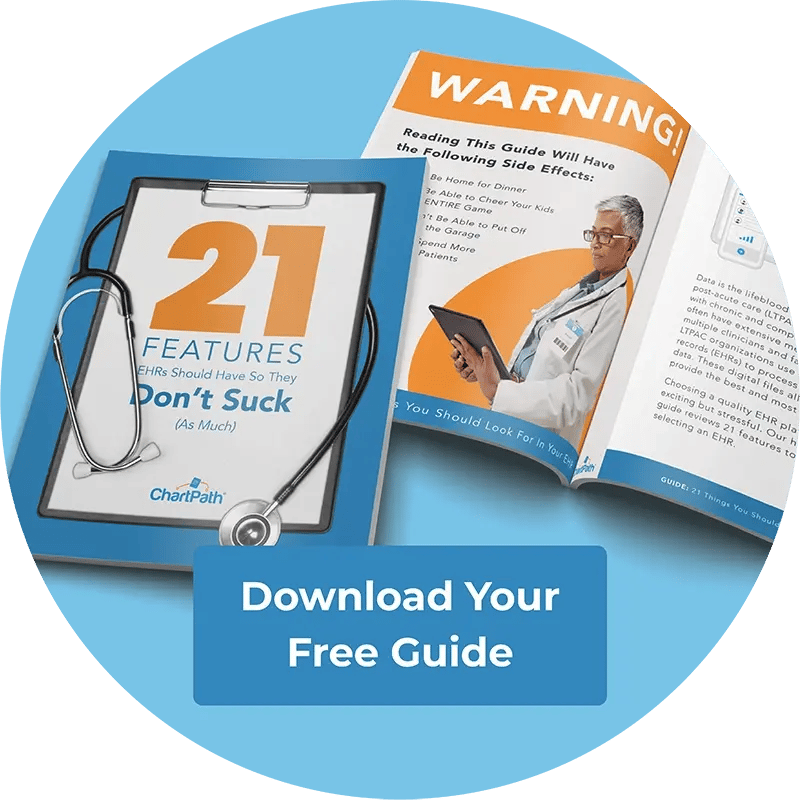Post Acute Care vs Skilled Nursing: Differences, Tools & Insights

Understanding the differences can be important for clinicians, administrators, and billing teams, as it can significantly impact operations and profitability.
For example, clinicians who understand the nuances of post-acute care and skilled nursing can better educate their patients so they make more informed decisions about their medical care. Administrators can also make smarter choices about the services they offer, while billing teams can bill more accurately, leading to greater reimbursement.
In this guide, we'll look at the differences between post-acute care vs skilled nursing. We'll define each term, highlight key similarities and differences, and examine the main challenges care coordinators face, especially around documentation and billing. We'll also offer recommendations to help you overcome common hurdles, including partnering with an EHR provider like ChartPath.
What Is Post-Acute Care?
After an acute health incident, patients often need additional support as they recover. Post-acute care provides this continued care across a variety of settings, including:
- Skilled nursing facilities (SNFs)
- Inpatient rehabilitation facilities (IRFs)
- Long-term acute care hospitals (LTACHs)
- Home-based post-acute care
Just as post-acute care can take place in different environments, it also encompasses a wide range of services, including:
- Wound care
- Physical therapy
- Occupational therapy
- Skilled nursing care
- Rehabilitation services
- Hospice
The duration of post-acute care services can vary, depending on the setting and the patient's needs. For example, the average length of stay at an IRF is 12–15 days, while an LTACH typically sees stays of over 25 days. Home health agency (HHA) services can range from a few weeks to several months.
Ultimately, the goal is to achieve the health outcomes prescribed by the patient's care team, though factors like insurance coverage also influence the length of stay.
What is Skilled Nursing?
Skilled nursing is a subset of post-acute care. It involves medical services provided by licensed healthcare professionals. These services are typically delivered in SNFs and require clinical expertise to ensure effective care.
Healthcare professionals who may deliver skilled nursing services include:
- Registered Nurses (RNs)
- Licensed Practical/Vocational Nurses (LPNs/LVNs)
- Occupational Therapists (OTs)
- Physical Therapists (PTs)
Common skilled nursing services include:
- Wound care
- Intravenous (IV) therapy
- Medication management
- Rehab services
As with other forms of post-acute care, the duration of skilled nursing home care services can vary based on a number of factors. On average, patients stay in a skilled nursing facility for 20 to 38 days. Medicare may cover a portion of the stay for up to 100 days.
Regardless of the length of stay, the primary goal is the same: to provide comprehensive care and medical management until the patient can safely resume daily activities to the fullest extent possible.
Comparison Table: Post-Acute Care vs Skilled Nursing
Since skilled nursing is a component of post-acute care, some overlap exists between the two. This comparison table of post-acute care vs skilled nursing highlights their key features:
|
|
Post-Acute Care |
Skilled Nursing |
|
Eligible Recipients |
Patients recovering from an acute medical event |
Patients requiring more advanced healthcare services |
|
Settings |
Long-term care hospitals, SNFs, IRFs, nursing homes, home-based care |
Primarily SNFs; sometimes home-based |
|
Length of Stay |
Varies by facility (IRFs: 12–15 days; LTACHs: >25 days; HHAs: up to 6 months) |
Typically 14–21 days |
|
Care Intensity |
Less intensive |
More intensive |
|
Services Offered |
Occupational therapy, physical therapy, speech-language pathology, assistance with daily activities |
IV therapy, wound care, medication administration, vital sign monitoring, ostomy care |
Understanding the differences between post-acute care vs skilled nursing helps clinicians determine which patients qualify for skilled nursing services and ensure they receive the appropriate care. It also helps administrators define the scope of practice at their facility, so they can configure operations accordingly.
Care Coordination in Post-Acute vs Skilled Nursing
One key difference between post-acute care vs skilled nursing is the way care is coordinated within each. Since SNFs provide more advanced nursing services, clinicians need to collaborate closely with healthcare professionals who deliver skilled nursing care. In contrast, other post-acute care facilities, such as nursing homes, often have less in-house clinician monitoring and oversight, making consistent communication about the patient's health status a must.
This difference becomes especially important when facilities implement an electronic medical record (EMR) system tailored to their operations. A specialized EMR that supports the specific needs of skilled nursing and other post-acute care facilities can reduce interoperability silos, allowing for better monitoring and communication among clinicians. The result is improved care coordination for patients and more efficient healthcare operations.
Documentation and Billing: Where It Gets Real
The clinical differences between post-acute care vs skilled nursing also create multiple operational differences. The main ones are:
-
Regulations and Billing: While all types of post-acute care must comply with regulations like HIPAA and other healthcare standards, the billing structures vary. For example, Medicare reimburses SNFs through the Skilled Nursing Facility Prospective Payment System (SNF PPS) on a per-diem basis. In contrast, HHAs typically receive payment every 60 days.
-
Workflows: Because SNFs provide more advanced medical services, clinicians often have heavier workloads and more stringent requirements. The services must be coded appropriately, so billing teams need accurate, up-to-date information to ensure proper reimbursement.
-
Documentation: Due to the complexity of care provided, SNFs also require more comprehensive documentation than other post-acute care facilities. A quality EMR system should include LTPAC documentation functionalities, such as wound measurement tools, to help skilled nursing staff thoroughly record the services they provide.
Since many healthcare organizations offer skilled nursing and other post-acute care services, it's important to choose an electronic health record (EHR) system equipped to support both. A well-tailored EHR can streamline clinical workflows and billing processes, improving productivity and profitability.
Common Challenges Clinicians Face
Silos between post-acute vs skilled nursing can complicate care coordination, documentation, and revenue cycle management (RCM). Some of the most common challenges include:
- Fragmented patient records during care transitions
- Lack of interoperability between systems
- Reimbursement delays and claim denials
- Clinician burnout caused by duplicate documentation
- Navigating MIPS and other regulatory programs across care types
Choosing the right EHR solution can help address these challenges. ChartPath's post-acute care EHR is designed to support the unique needs of both post-acute and skilled nursing facilities, eliminating the barriers that often arise between them. From interoperability to advanced medical coding capabilities, ChartPath can simplify care transitions, maximize profits, and improve patient health outcomes by creating a seamless experience across all post-acute care settings.
Bridging the Gap with the Right EHR: The ChartPath Advantage
Healthcare organizations face numerous challenges in delivering high-quality care, from gaps in care coordination to billing and documentation inefficiencies. ChartPath's advanced EHR platform is built to help clinicians overcome these operational hurdles.
Equipped with powerful billing, charting, and care coordination features, ChartPath streamlines documentation workflows, reduces billing errors, removes interoperability silos, and maximizes profitability. Purpose-built for all types of post-acute care, it empowers teams to work more efficiently and enhances patient care coordination. That's the ChartPath advantage — request your demo today.
Blog Post Tags
SNFGet Awesome Content Delivered Straight to Your Inbox!
Posts by topic
- EHR
- Better Charting
- LTPAC
- AI
- RCM
- Compliance
- Healthcare Trends
- Press Release
- GUIDE
- reporting
- Artificial Intelligence
- Assisted Living
- Automation
- Behavioral Health
- Business
- Events
- General
- MIPS
- Operations
- Patient Outcomes
- Physician Billing Services
- Population Health Management
- Resumption of Care
- SNF
- TCM
- Value Based Care
- eCR
- interoperability
- partners
- regulations
- regulatory See All See Less




